AP bio unit 8
1/44
There's no tags or description
Looks like no tags are added yet.
Name | Mastery | Learn | Test | Matching | Spaced |
|---|
No study sessions yet.
45 Terms
Ecology
the study of the interactions organisms have with each other and the environment
5 levels of ecology:
organism - an individual
population - all organisms in an area belonging to the same species (Ex. herd of zebras)
community - multiple populations together form a community
ecosystem - all species in the community plus all the nonliving parts like water and rocks
biosphere - where all life exists (Ex. desert biome, rainforest biome)
Population Density
number of individuals per unit area. Can affect and is determined by resource availability in that area
Distribution patterns
The pattern of dispersal of individuals across an area affected by both abiotic and biotic resources
Random distribution - common for plants with seeds that are wind dispersed so the seeds land in random places
Uniform distribution - organisms that defend territories
clumped distribution - most common and clumps usually form around resources
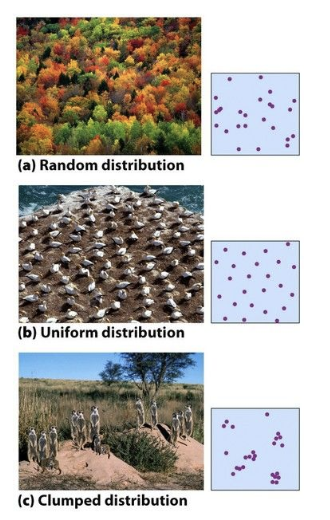
abiotic
nonliving (like water, light, temperature, precipitation)
biotic
living (food, mates)
Dispersal
The ability of a specific organism to move through its habitat has an impact on its distribution patterns.
Wind
another organisms
currents and tides
If resources are fairly even then it could be beneficial to claim a specific territory
clumping can be advantageous for hunting or protection and it allows for more efficient mating
some species will have different distribution patterns over different times of their life (Ex. territorial for most of the time but clumped during migration or mating season)
Limiting Factors
Environmental features that partially determine where an organism can live (Ex. trout can’t live in warm water because there is not enough dissolved oxygen so oxygen becomes the limiting factor)
Density-dependent - vary in importance or effect based on the density of the population (Ex. competition, predations, and disease)
Density-independent - will impact the population regardless of the density of the population (Ex. fires, floods, storms, habitat destruction)
Biotic potencial
highest possible rate of natural increase when resources are unlimited
Population growth
depends on several factors
usual number of offspring per reproductive event
chances of survival until age of reproduction
how often each individual reproduces
age at which reproduction begins
Basically:
population increases when birth rate is greater than death rate
population decreases when birth rate is lower than death rate
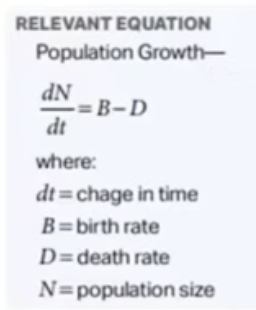
Exponential growth
rapid, unrestricted growth
resources are available
nothing limits population’s growth
Ex. bacterial growth and when organisms are first introduced into a new area
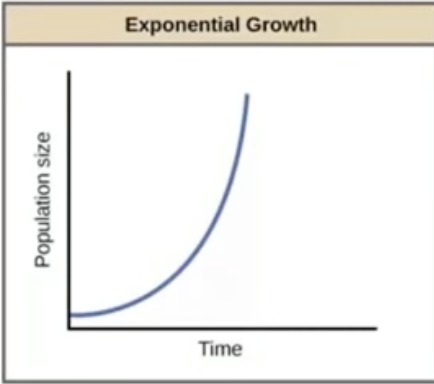
Logistic Growth
growth is limited by resource availability
Ex. paramecium population in a lab because food and space is limited

Exponential Growth Calculations
rmax doesn’t change even if the population gets larger
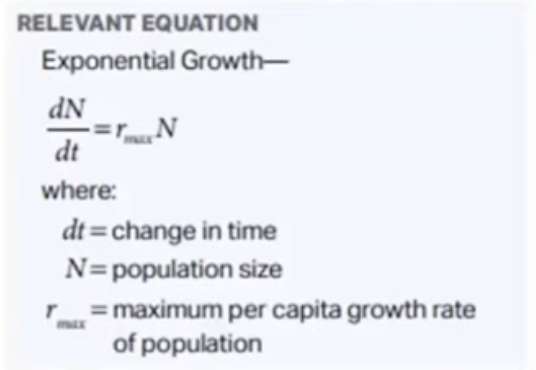
Carrying capacity (K) and logistic growth
the maximum number of individuals an environment can support without environmental degradation
populations don’t level out exactly at carrying capacity they bounce around the line
carring capacity can change, due to a change in limiting factors
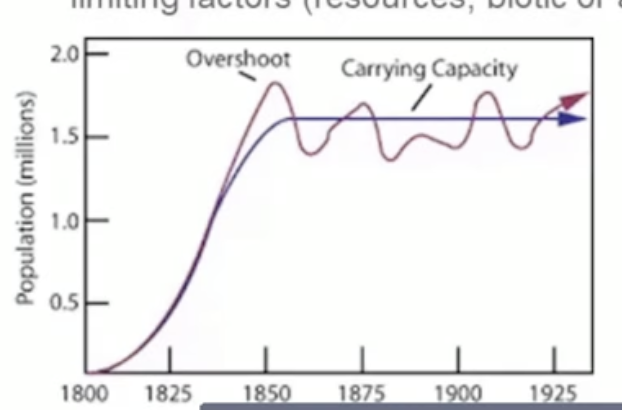
Logistic Growth Calculations
resource availability
per capita growth rate (rmax) gets smaller as the population approaches its maximum size (K)
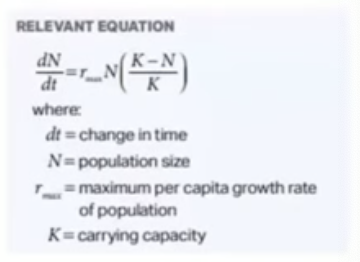
Ecological community
All of the interacting populations in a single geographic area which impacts the survival and reproduction of each species in a community
intraspecific interactions - occur between individuals in the same species
interspecific interactions - between members of different species
Ecological Succession
The composition of a community will change over time in a predictable way.
As new populations are established, they change the environment in ways that make it suitable for other populations to move in
climax community - the most suitable community for that particular habitat
Primary and secondary succesion
primary succession - when there is barren rock with no soil so pioneer species like lichen and moss much first breakdown the rock to make soil
secondary succession - comes after a disturbance that leaves behind the soil. Abandoned farmland or wildfires may lead to a change in the community over time
The biggest difference is the starting point - primary begins with just rocks while secondary has more

Competition
competition for resources can be intraspecific or interspecific. The competitive exclusion principle states that no two species can coexist in exactly the same niche. So competition can lead to Niche partitioning. In the picture you can see that each bird occupies a slightly different niche
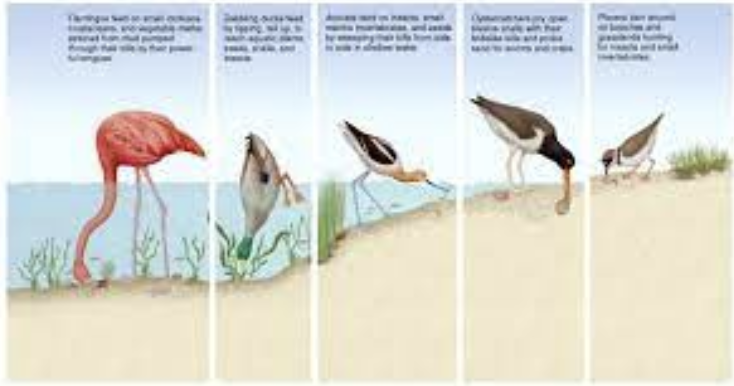
predator/prey
predator benefits (+) while prey is harmed (-) and the predator is always in a higher trophic level. usually there is more prey than predator

symbiotic
long-term close relationship between two species
mutualism (+,+)
commensalism (+, 0)
parasitism (+,-)

Cooperation
Can be interspecific or intraspecific and enhances the ability to access and/or utilizes resources. (Ex. pack hunting, herd behavior, nitrogen-fixing bacteria, alarm calling in meerkats)
Biodiversity
Based on species richness (number of different species) and relative abundance (proportion of each species in a community). the higher the biodiversity, the greater its resilience to environmental change
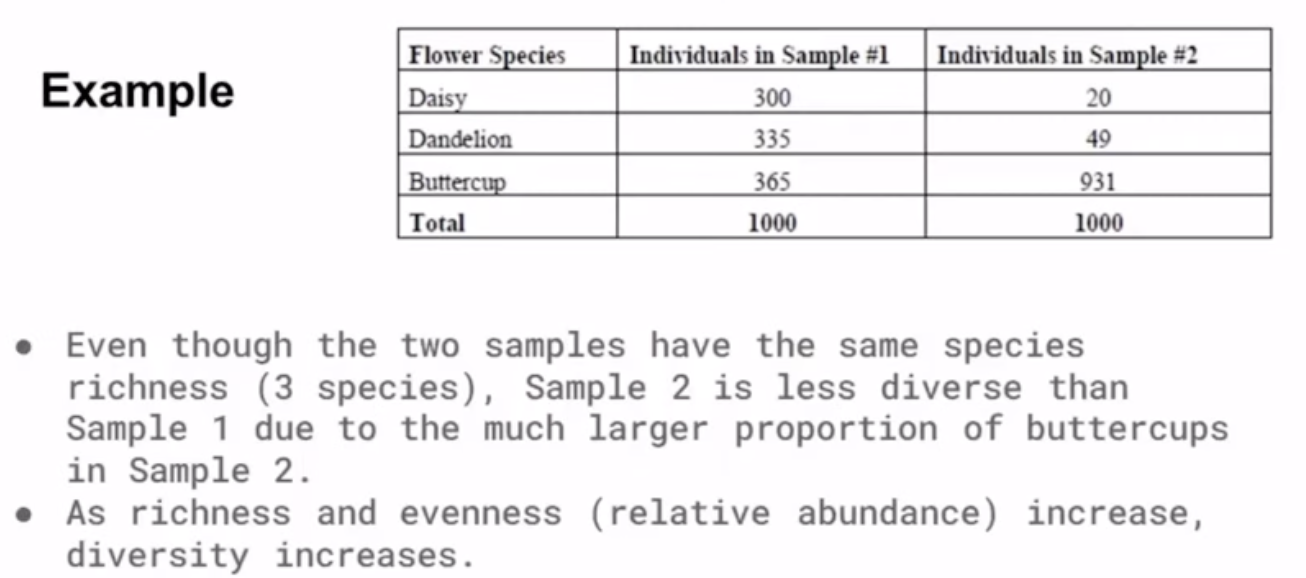
simpson’s diversity index
This equation takes into account both species richness and relative abundance, the closer the answer is to 1 the greater the biodiversity
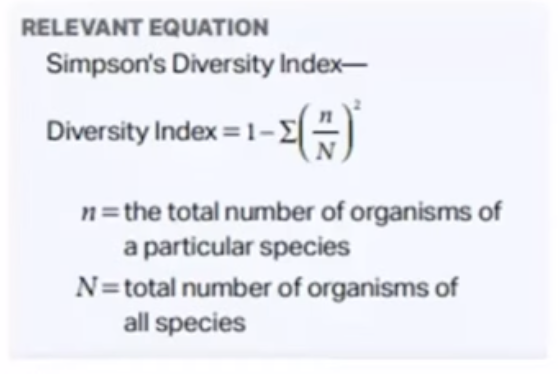
Keystone species
a species on which other species in an ecosystem largely depend, such that if it were removed the ecosystem would change drastically
trophic cascade
when one trophic level is reduced or removed which cascades down to trophic levels below
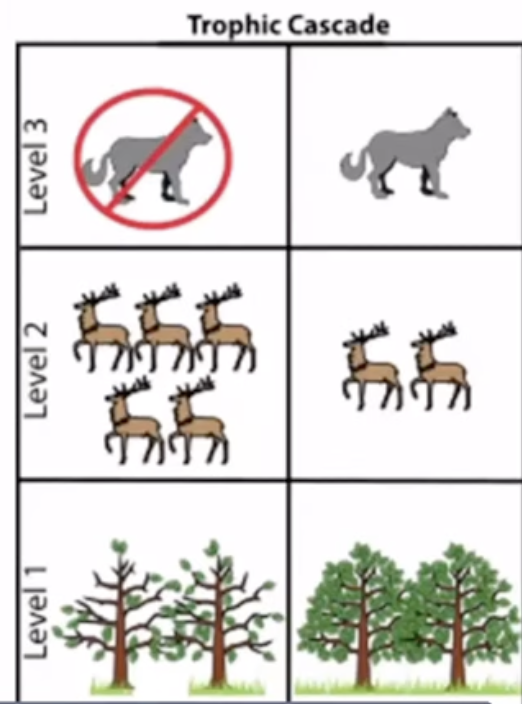
Effect of larger population on intraspecific competition?
Intraspecific competition is between the same species over resources. As population size increases competition increases which reduces the successful reproduction rate which reduces population growth.
Effect of larger population on interspecific competition?
Interspecific competition is predation by another species and as populations grow individuals are more likely to be killed so reduced individual survival and population growth.
Effect of larger population on disease and parasites?
Disease and parasites become more common when populations increase in size so reduces population growth
Effect of larger population on social behavior
Social behaviors are how individuals within a species interact with each other and as population increases negative social behaviors (like cannibalism or reduced parental care) increase which reduces individual survival and thus overall population growth.
Ecosystem
contains a community but also the abiotic environment so organisms interact among themselves and with the physical and chemical environment
Energy flow through an ecosytem
Producers absorb solar energy and use photosynthesis to convert sunlight energy to chemical energy. This is a one way flow because as this energy moves up the food chain some is used as an energy source and some lost to the environment, so energy does not get recycled like nutriets does
Autotrophs
need only inorganic nutrients and an outside energy source to produce energy rich organic nutrients. there are two ways:
photosynthesis - the most common method and uses sunlight to turn carbon dioxide and water into energy rich molecules
chemosynthesis - used by some bacteria and they capture energy from oxidizing small inorganic molecules (like ammonia, hydrogen, hydrogen sulfide) present in the environment and use the energy to make organic compounds and water. this process can occur in the absence of oxygen
Heterotrophs
consumers; capture energy present in carbon compounds produced by other organisms. Include:
herbivores
carnivores
omnivores
detritus feeders/detritivores - feed on decomposing particles of organic matter/waste which is called detritus (Ex. earthworms)
decomposers - acquire nutrients by breaking down dead organic matter into simple inorganic substances (Ex. bacteria, fungi) and play a vital role in an ecosystem because they release inorganic substances that are taken up by plants. the difference between decomposers and detritivores is that detritivores will decompose by eating, digesting, and pooping out organic matter while decomposers will secrete digestive enzymes onto the dead material to break it down externally.
Endothermic organisms
uses internal metabolic processes to generate heat and maintain its body temperature. Endotherms may also shiver, grow thick fur, or keep close to each other to generate warmth and sweat or pant to cool down (Ex. mammals, birds, dogs)
Exothermic organisms
do not generate enough heat through their metabolic processes regulate body temperature behaviorally by moving into or out of the sun or aggregating (keeping close together) (Ex. fish, amphibians, reptiles, invertebrates)
Organism size and metabolic rate
generally the smaller the organism, the higher the metabolic rate
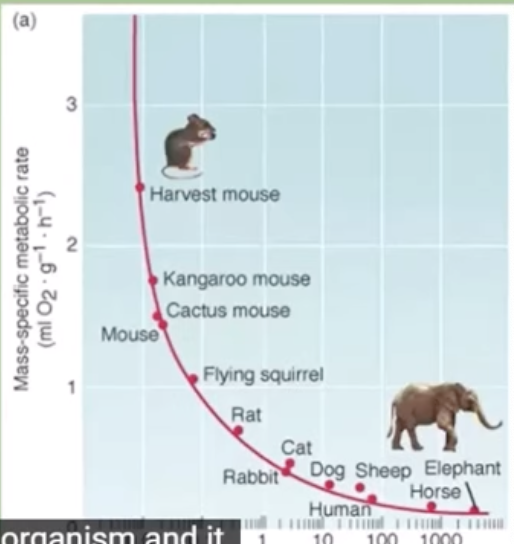
Reproductive strategies and energy availability
Different organisms use various reproductive strategies in response to energy availability. Include r-strategists, K-strategists, and seasonal reproduction (animals reproduce when food is plentiful and plants when sunlight and water is available)
R - strategists
produce lots of offspring (but very few survive), invest little parental care into each offspring, are considered opportunistic species who take advantage of when resources are plentiful, and their populations cycles through Boom & bust growth, examples include bacteria, weeds, insects
K - strategists
have fewer offspring but invest parental care into each offspring so more survive, K - strategists reach sexual maturity later and reproduce less often, they are usually larger, they are an equilibrium species so its population fluctuates less, include humans, elephants, kangaroos, etc.
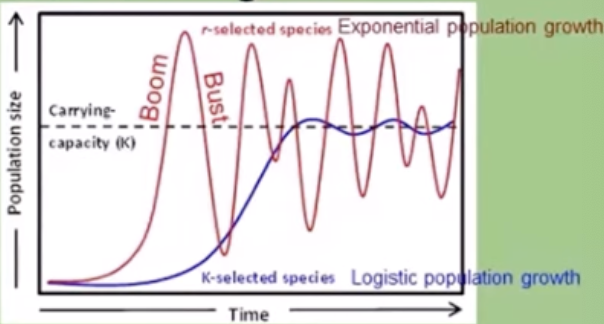
Comparison of r and k strategists
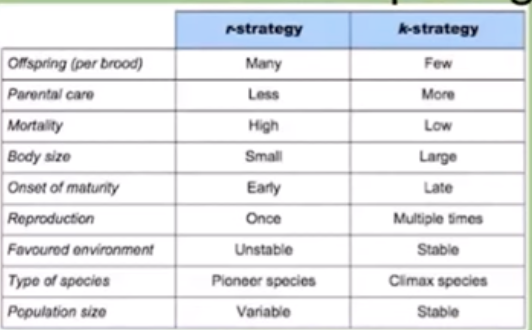
trophic levels
first trophic level - produces
second - primary consumers
third- secondary consumers
generally doesn’t go much farther because only 10% of energy from one level is available to the next because an organism stores 10% of the energy it consumes in its body as biomass which is then passed onto the next level when it is eaten, the rest of the energy is lost as heat/waste or used in cellular respiration
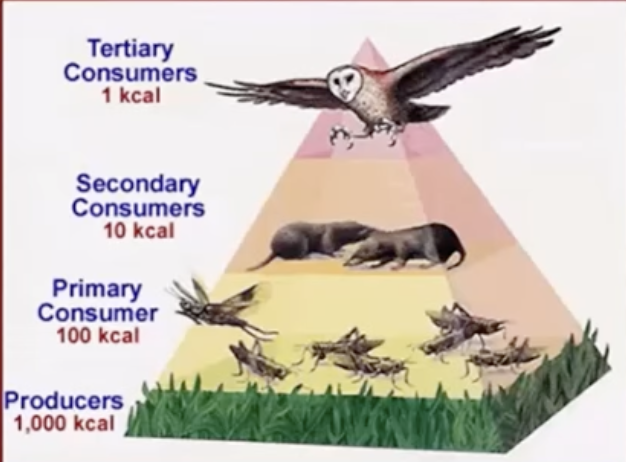
Ecological Pyramids
the biomass, number of organisms, and energy decreases as you go higher up the pyramid

Disruptions to ecosystems
Human impacts accelerate changes at local and global levels and some examples include:
introduction of new diseases -
invasive species - a species that is non-native that spreads from the point of introduction and become abundant. non-native species are only called invasive when they have an impact and alter their new environment
habitat destruction
pollution - adding fertilizers and pesticides can affect the ecosystem and can lead to biological magnification (where a substance becomes more concentrated in organisms in the higher trophic levels of a food web and this effects organisms at higher trophic levels more because the concentration becomes high enough to actually effect them, Ex. DDT)
Gross Primary Productivity (GPP)
All energy that comes from photosynthesis
Net Primary Productivity
Energy available to the second trophic level (primary consumers) and it’s the GPP - energy used (cellular respiration, waste/heat). Biomass is what moves up the trophic level and it’s about 10% of what the primary consumers ate.